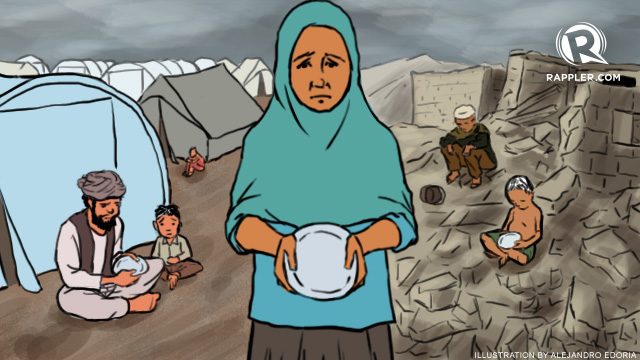SUMMARY
This is AI generated summarization, which may have errors. For context, always refer to the full article.

MANILA, Philippines – When people are forced to flee their homes, they practically have nothing as they face an uncertain future.
As various circumstances – often violent in nature – continue to disturb them in their communities, they are left with no choice but to leave behind their possibly only source of livelihood: mostly agricultural lands.
These lands, however, are not only there for shelter and livelihood. They also serve as source of food especially in far-flung communities. With only the clothes on their backs as sole possession and no money, internally-displaced people often go hungry. (READ: How conflict can lead to food insecurity and hunger)
Such is also the case for refugees, only worse.
The United Nations High Commissioner for Refugees (UNHCR) defines refugees in the 1951 Refugee Convention as people who are outside of the country of nationality out of “fear of being persecuted for reasons of race, religion, nationality, membership of a particular social group or political opinion.”
In recent times, the number of refugees has risen due to various conflicts happening around the world.
As of 2014, the UNHCR says there are 51.2 million refugees around the world. More than half of them came from Afghanistan, Syria, and Somalia – countries that are plagued by years of violence and conflict.
The United Nations Children’s Fund (Unicef) meanwhile reported at least 480,000 cases of severe malnutrition among children refugees in Somalia, Kenya, and Ethiopia.
The Rohingya people
The recent controversial refugees right now are the Rohingya. These are Muslim minorities who live in coastal villages in Myanmar.
However, Myanmar does not recognize the Rohingya people as citizens or ethnic group. This resulted in discrimination for decades. The United Nations (UN) considers them as the “world’s most persecuted minorities” after various reports show the 1.3 million Rohingya as victims of violence in Myanmar. (READ: FAST FACTS: Who are the Rohingya?)
Victims of discrimination, they are being forced out of their homes or their lands confiscated. They are settled in overcrowded camps with limited access to clean water, food, and health services.
Unicef reported that between March and June 2014, the number of cases of severe malnutrition rose to 1,000. At least 23% of cases suffered from acute malnutrition.
With these problems, human traffickers preyed on the desperation of the Rohingya people. They were put on boats out to sea only to be abandoned as Myanmar military action rose.
The journey to what was supposed to be “freedom” led to months of depressing circumstances.
Hundreds of thousands of migrants were isolated at sea for months – plagued by hunger, diseases, and death. Reports indicated that their usual meals consist of small quantities of rice and 3 dried chilies. Women ate twice, while men once, sometimes not at all.
With no humanitarian assistance from neighboring countries, they fought over sustenance available. Water and food became a prize and unfortunately, threatened lives. (READ: Myanmar’s Rohingya face hunger, death on brutal sea exodus)

The recent worldwide outrage pushed countries to be lenient – Malaysia and Indonesia offered to take in at least 7,000 “irregular migrants” provided they settle the problem within a year.
Meanwhile, other countries have also expressed an intent to offer refuge to the Rohingya, including the Philippines and the United States.
Looking forward
The problem however does not end with rescuing the Rohingya people from the sea. It is highly dependent now on host countries whether the world’s most persecuted community will finally have a shot at decent living conditions.
Malnutrition may become more apparent as they settle in refugee camps around the world, especially if support from others is inadequate.
Among Somali refugees for example, the UNHCR expressed in 2014 concern over the high incidence of malnutrition among children in camps scattered across Kenya and Ethiopia. The prevalence, according to the agency, is at 30 to 40%.
What would make them better?
According to the World Food Programme (WFP), refugee camps should have:
- Sufficient storage facilities
- Enough food available that are restocked and distributed every 2 weeks
- Efficient on-time food delivery
- Non-food commodities
Refugees suffering from severe malnutrition should immediately be treated to prevent drastic effects like death.
But in the end, it is important that the whole world contributes to ending the problem of refugees.
As the Thai foreign ministry said in a statement, the international community should “work collectively to solve this problem, which should not be left to any country alone.” – Rappler.com
Add a comment
How does this make you feel?
There are no comments yet. Add your comment to start the conversation.